A Review of Plasma Synthesis Methods for Polymer Films and Nanoparticles under Atmospheric Pressure Conditions
Abstract
:1. Introduction
2. Synthesis Method Using Gas/Aerosol-Type Precursors (GATP)
2.1. Atmospheric-Pressure Plasma Jet (APPJ) Method
2.2. Planar Dielectric-Barrier Discharge (DBD) Method
3. Synthesis Method Using Liquid-Type Precursors
3.1. Atmospheric-Pressure Plasma (APP) Generated by Outside Bulk Liquid Precursors
3.2. Atmospheric-Pressure Plasma (APP) Generated by Inside Bulk Liquid Precursors
4. Plasma Polymerization
4.1. Synthesis of Polymers Using Plasma Techniques
4.2. Characterization and Chemical Structure of the Polymerized Films Obtained Using APP Techniques
5. Main Properties and Current Applications of the Polymers Obtained via APP Polymerization
6. Conclusions and Future Perspectives
Author Contributions
Funding
Institutional Review Board Statement
Informed Consent Statement
Data Availability Statement
Conflicts of Interest
References
- Plasma polymerization. In The Plasma Chemistry of Polymer Surfaces: Advanced Techniques for Surface Design, 1st ed.; Wiley-VCH: Weinheim, Germany, 2021; pp. 337–375.
- de Wilde, P. Vermischte mittheilungen. Berichte 1876, 7, 352. [Google Scholar]
- Berthelot, M. Formation de l’acétylène dans les combustions incomplètes. Ann. Chim. Phys. 1866, 9, 413. [Google Scholar]
- Berthelot, M. Action Réciproque des carbures d’hydrogène. synthèse de styrolène, de la napthaline, de l’anthracéne. Ann. Chim. Phys. 1867, 12, 5–52. [Google Scholar]
- Thenard, P.; Thenard, A. Acétylène liquéfié et solidifié sous l’influence de l’effluve électrique. Comptes Rendus 1874, 78, 219. [Google Scholar]
- Schüler, H.; Reinebeck, L. Über neue spektren in der glimmentladung mit naphthalindampf. Z. Nat. A 1951, 6a, 270–275. [Google Scholar] [CrossRef]
- Schüler, H.; Reinebeck, L. Über diacetylen in der glimmentladung. Z. Nat. A 1954, 9a, 350–354. [Google Scholar] [CrossRef]
- Schüler, H.; Prchal, K.; Kloppenburg, E. Chemische reaktionen in der positiven säule einer glimmentladung reaktionsprodukte des benzols. Z. Nat. A 1960, 15a, 308–310. [Google Scholar] [CrossRef]
- König, H.; Helwig, G. Über dünne aus kohlenwasserstoffen durch elektronen- oder ionenbeschuß gebildete schichten. Z. Phys. 1951, 129, 491–503. [Google Scholar] [CrossRef]
- Goodman, J. The formation of thin polymer films in the gas discharge. J. Polym. Sci. 1960, 44, 551–552. [Google Scholar] [CrossRef]
- Inagaki, N.; Ohkubo, J. Plasma polymerization of hexafluoropropene/methane mixtures and composite membranes for gas separations. J. Memb. Sci. 1986, 27, 63–75. [Google Scholar] [CrossRef]
- Lawton, E.L. Adhesion improvement of tire cord induced by gas plasma. J. Appl. Polym. Sci. 1974, 18, 1557–1574. [Google Scholar] [CrossRef]
- Stille, J.K.; Rix, C.E. The reaction of halobenzenes in a radiofrequency glow discharge. J. Org. Chem. 1966, 31, 1591–1594. [Google Scholar] [CrossRef]
- Denaro, A.R.; Owens, P.A.; Crawshaw, A. Glow discharge polymerization-II α-methylstyrene, ω-methylstyrene and allylbenzene. Eur. Polym. J. 1969, 5, 471–482. [Google Scholar] [CrossRef]
- Kobayashi, H.; Bell, A.T.; Shen, M. Formation of an amorphous powder during the polymerization of ethylene in a radio-frequency discharge. J. Appl. Polym. Sci. 1973, 17, 885–892. [Google Scholar] [CrossRef]
- Yasuda, H. Plasma polymerization for protective coatings and composite membranes. J. Memb. Sci. 1984, 18, 273–284. [Google Scholar] [CrossRef]
- Inagaki, N.; Tasaka, S.; Ikeda, Y. Plasma polymerization of copper phthalocyanines and application of the plasma polymer films to NO2 gas sensor device. J. Appl. Polym. Sci. 1995, 55, 1451–1464. [Google Scholar] [CrossRef]
- He, J.-H.; Singamaneni, S.; Ho, C.H.; Lin, Y.-H.; McConney, M.E.; Tsukruk, V.V. A thermal sensor and switch based on a plasma polymer/ZnO suspended nanobelt bimorph structure. Nanotechnology 2009, 20, 065502. [Google Scholar] [CrossRef]
- Kim, M.; Kang, T.W.; Kim, S.H.; Jung, E.H.; Park, H.H.; Seo, J.; Lee, S.J. Antireflective, self-cleaning and protective film by continuous sputtering of a plasma polymer on inorganic multilayer for perovskite solar cells application. Sol. Energy Mater. Sol. Cells 2019, 191, 55–61. [Google Scholar] [CrossRef]
- Seo, H.J.; Gil, Y.E.; Hwang, K.-H.; Ananth, A.; Boo, J.-H. Synthesis and characterization of plasma-polymer gate dielectric films for graphene field effect transistor devices. Electron. Mater. Lett. 2019, 15, 396–401. [Google Scholar] [CrossRef]
- Truica-Marasescu, F.; Wertheimer, M.R. Nitrogen-rich plasma-polymer films for biomedical applications. Plasma Process. Polym. 2008, 5, 44–57. [Google Scholar] [CrossRef]
- Vasani, R.B.; Szili, E.J.; Rajeev, G.; Voelcker, N.H. On-demand antimicrobial treatment with antibiotic-loaded porous silicon capped with a pH-responsive dual plasma polymer barrier. Chem.-An Asian J. 2017, 12, 1605–1614. [Google Scholar] [CrossRef]
- Coad, B.R.; Scholz, T.; Vasilev, K.; Hayball, J.D.; Short, R.D.; Griesser, H.J. Functionality of proteins bound to plasma polymer surfaces. ACS Appl. Mater. Interfaces 2012, 4, 2455–2463. [Google Scholar] [CrossRef]
- Vasilev, K. Nanoengineered plasma polymer films for biomaterial applications. Plasma Chem. Plasma Process. 2014, 34, 545–558. [Google Scholar] [CrossRef]
- Bhatt, S.; Pulpytel, J.; Aref-Khonsari, F. Low and atmospheric plasma polymerisation of nanocoatings for bio-applications. Surf. Innov. 2015, 3, 63–83. [Google Scholar] [CrossRef]
- Hegemann, D.; Lorusso, E.; Butron-Garcia, M.-I.; Blanchard, N.E.; Rupper, P.; Favia, P.; Heuberger, M.; Vandenbossche, M. Suppression of hydrophobic recovery by plasma polymer films with vertical chemical gradients. Langmuir 2016, 32, 651–654. [Google Scholar] [CrossRef] [PubMed]
- Fan, Y.; Li, X.; Yang, R. The surface modification methods for constructing polymer-coated stents. Int. J. Polym. Sci. 2018, 2018, 3891686. [Google Scholar] [CrossRef]
- Rao, J.; Bao, L.; Wang, B.; Fan, M.; Feo, L. Plasma surface modification and bonding enhancement for bamboo composites. Compos. Part B Eng. 2018, 138, 157–167. [Google Scholar] [CrossRef]
- Langmuir, I. Oscillations in ionized gases. Proc. Natl. Acad. Sci. USA 1928, 14, 627–637. [Google Scholar] [CrossRef] [Green Version]
- Khelifa, F.; Ershov, S.; Habibi, Y.; Snyders, R.; Dubois, P. Free-radical-induced grafting from plasma polymer surfaces. Chem. Rev. 2016, 116, 3975–4005. [Google Scholar] [CrossRef]
- Ishijima, T.; Nosaka, K.; Tanaka, Y.; Uesugi, Y.; Goto, Y.; Horibe, H. A high-speed photoresist removal process using multibubble microwave plasma under a mixture of multiphase plasma environment. Appl. Phys. Lett. 2013, 103, 1–6. [Google Scholar] [CrossRef]
- Bitar, R.; Cools, P.; Geyter, N.D.; Morent, R. Acrylic acid plasma polymerization for biomedical use. Appl. Surf. Sci. 2018, 448, 168–185. [Google Scholar] [CrossRef]
- Moreau, M.; Orange, N.; Feuilloley, M.G.J. Non-thermal plasma technologies: New tools for bio-decontamination. Biotechnol. Adv. 2008, 26, 610–617. [Google Scholar] [CrossRef] [PubMed]
- Mariotti, D.; Sankaran, R.M. Microplasmas for nanomaterials synthesis. J. Phys. D Appl. Phys. 2010, 43, 323001. [Google Scholar] [CrossRef]
- Özçiçek, N.P.; Pekmez, K.; Holze, R.; Yildiz, A. Spectroelectrochemical investigations of aniline-thiophene copolymers in acetonitrile. J. Appl. Polym. Sci. 2003, 90, 3417–3423. [Google Scholar] [CrossRef]
- Udum, Y.A.; Pekmez, K.; Yildiz, A. Electrochemical preparation of a soluble conducting aniline-thiophene copolymer. Eur. Polym. J. 2005, 41, 1136–1142. [Google Scholar] [CrossRef]
- Xu, Y.; Dai, L.; Chen, J.; Gal, J.-Y.; Wu, H. Synthesis and characterization of aniline and aniline-o-sulfonic acid copolymers. Eur. Polym. J. 2007, 43, 2072–2079. [Google Scholar] [CrossRef]
- Mun, M.K.; Lee, W.O.; Park, J.W.; Kim, D.S.; Yeom, G.Y.; Kim, D.W. Nanoparticles synthesis and modification using solution plasma process. Appl. Sci. Converg. Technol. 2017, 26, 164–173. [Google Scholar] [CrossRef] [Green Version]
- Chou, W.-C.; Liu, W.-J. Study of dye sensitized solar cell application of TiO2 films by atmospheric pressure plasma deposition method. In Proceedings of the International Conference on Electronics Packaging (ICEP), Sapporo, Japan, 20–22 April 2016; pp. 664–668. [Google Scholar]
- Muzammil, I.; Li, Y.; Lei, M. Tunable wettability and pH-responsiveness of plasma copolymers of acrylic acid and octafluorocyclobutane. Plasma Process. Polym. 2017, 14, 1–10. [Google Scholar] [CrossRef]
- Khoo, Y.S.; Lau, W.J.; Liang, Y.Y.; Karaman, M.; Gürsoy, M.; Lai, G.S.; Ismail, A.F. Rapid and eco-friendly technique for surface modification of TFC RO membrane for improved filtration performance. J. Environ. Chem. Eng. 2021, 9, 105227. [Google Scholar] [CrossRef]
- Liu, T.; Yang, F.; Li, Y.; Ren, L.; Zhang, L.; Xu, K.; Wang, X.; Xu, C.; Gao, J. Plasma synthesis of carbon nanotube-gold nanohybrids: Efficient catalysts for green oxidation of silanes in water. J. Mater. Chem. A 2014, 2, 245–250. [Google Scholar] [CrossRef]
- Rezaei, F.; Vanraes, P.; Nikiforov, A.; Morent, R.; Geyter, N.D. Applications of plasma-liquid systems: A review. Mateials 2019, 12, 2751. [Google Scholar] [CrossRef] [Green Version]
- Saito, G.; Akiyama, T. Nanomaterial synthesis using plasma generation in liquid. J. Nanomater. 2015, 2015, 123696. [Google Scholar] [CrossRef] [Green Version]
- Fauchais, P.; Etchart-Salas, R.; Rat, V.; Coudert, J.F.; Caron, N.; Wittmann-Ténèze, K. Parameters controlling liquid plasma spraying: Solutions, sols, or suspensions. J. Therm. Spray Technol. 2008, 17, 31–59. [Google Scholar] [CrossRef]
- Nie, Q.Y.; Cao, Z.; Ren, C.S.; Wang, D.Z.; Kong, M.G. A two-dimensional cold atmospheric plasma jet array for uniform treatment of large-area surfaces for plasma medicine. New J. Phys. 2009, 11, 115015. [Google Scholar] [CrossRef]
- Nie, Q.-Y.; Ren, C.-S.; Wang, D.-Z.; Zhang, J.-L. A simple cold Ar plasma jet generated with a floating electrode at atmospheric pressure. Appl. Phys. Lett. 2008, 93, 011503. [Google Scholar] [CrossRef]
- Kim, H.; Brockhaus, A.; Engemann, J. Atmospheric pressure argon plasma jet using a cylindrical piezoelectric transformer. Appl. Phys. Lett. 2009, 95, 211501. [Google Scholar] [CrossRef]
- Yang, P.; Zhang, J.; Guo, Y. Synthesis of intrinsic fluorescent polypyrrole nanoparticles by atmospheric pressure plasma polymerization. Appl. Surf. Sci. 2009, 255, 6924–6929. [Google Scholar] [CrossRef]
- Teslaru, T.; Topala, I.; Dobromir, M.; Pohoata, V.; Curecheriu, L.; Dumitrascu, N. Polythiophene films obtained by polymerization under atmospheric pressure plasma conditions. Mater. Chem. Phys. 2016, 169, 120–127. [Google Scholar] [CrossRef]
- Zhang, P.; Zhang, S.; Kong, F.; Zhang, C.; Dong, P.; Yan, P.; Cheng, X.; Ostrikov, K.K.; Shao, T. Atmospheric-pressure plasma jet deposition of bumpy coating improves polypropylene surface flashover performance in vacuum. Surf. Coat. Technol. 2020, 387, 125511. [Google Scholar] [CrossRef]
- Ricci Castro, A.H.; Kodaira, F.V.P.; Prysiazhnyi, V.; Mota, R.P.; Kostov, K.G. Deposition of thin films using argon/acetylene atmospheric pressure plasma jet. Surf. Coat. Technol. 2017, 312, 13–18. [Google Scholar] [CrossRef] [Green Version]
- Van Vrekhem, S.; Morent, R.; Geyter, N.D. Deposition of a PMMA coating with an atmospheric pressure plasma jet. J. Coat. Technol. Res. 2018, 15, 679–690. [Google Scholar] [CrossRef]
- Pandiyaraj, K.N.; Ramkumar, M.C.; Kumar, A.A.; Vasu, D.; Padmanabhan, P.V.A.; Tabaei, P.S.E.; Cools, P.; Geyter, N.D.; Morent, R.; Jaganathan, S.K. Development of phosphor containing functional coatings via cold atmospheric pressure plasma jet—Study of various operating parameters. Appl. Surf. Sci. 2019, 488, 343–350. [Google Scholar] [CrossRef]
- Doherty, K.G.; Oh, J.S.; Unsworth, P.; Sheridan, C.M.; Weightman, P.; Bradley, J.W.; Williams, R.L. Plasma polymerization using helium atmospheric-pressure plasma jet with heptylamine monomer. Plasma Process. Polym. 2019, 16, 1–10. [Google Scholar] [CrossRef]
- Kodaira, F.V.P.; Ricci Castro, A.H.; Prysiazhnyi, V.; Mota, R.P.; Quade, A.; Kostov, K.G. Characterization of plasma polymerized HMDSN films deposited by atmospheric plasma jet. Surf. Coat. Technol. 2017, 312, 117–122. [Google Scholar] [CrossRef] [Green Version]
- Hossain, M.M.; Trinh, Q.H.; Nguyen, D.B.; Sudhakaran, M.S.P.; Mok, Y.S. Formation of plasma-polymerized superhydrophobic coating using an atmospheric-pressure plasma jet. Thin Solid Films 2019, 675, 34–42. [Google Scholar] [CrossRef]
- Malinowski, S.; Herbert, P.A.F.; Rogalski, J.; Jaroszyńska-Wolińska, J. Laccase enzyme polymerization by soft plasma jet for durable bioactive coatings. Polymers 2018, 10, 532. [Google Scholar] [CrossRef] [PubMed] [Green Version]
- Jang, H.J.; Park, C.-S.; Jung, E.Y.; Bae, G.T.; Shin, B.J.; Tae, H.-S. Synthesis and properties of thiophene and aniline copolymer using atmospheric pressure plasma jets copolymerization technique. Polymers 2020, 12, 2225. [Google Scholar] [CrossRef] [PubMed]
- Park, C.-S.; Jung, E.Y.; Jang, H.J.; Bae, G.T.; Shin, B.J.; Tae, H.-S. Synthesis and properties of plasma-polymerized methyl methacrylate via the atmospheric pressure plasma polymerization technique. Polymers 2019, 11, 396. [Google Scholar] [CrossRef] [Green Version]
- Park, C.-S.; Kim, D.Y.; Kim, D.H.; Lee, H.-K.; Shin, B.J.; Tae, H.-S. Humidity-independent conducting polyaniline films synthesized using advanced atmospheric pressure plasma polymerization with in-situ iodine doping. Appl. Phys. Lett. 2017, 110, 033502. [Google Scholar] [CrossRef] [Green Version]
- Kim, D.H.; Park, C.-S.; Kim, W.H.; Shin, B.J.; Hong, J.G.; Park, T.S.; Seo, J.H.; Tae, H.-S. Influences of guide-tube and bluff-body on advanced atmospheric pressure plasma source for single-crystalline polymer nanoparticle synthesis at low temperature. Phys. Plasmas 2017, 24, 023506. [Google Scholar] [CrossRef] [Green Version]
- Kim, J.Y.; Iqbal, S.; Jang, H.J.; Jung, E.Y.; Bae, G.T.; Park, C.-S.; Tae, H.-S. In-situ iodine doping characteristics of conductive polyaniline film polymerized by low-voltage-driven atmospheric pressure plasma. Polymers 2021, 13, 418. [Google Scholar] [CrossRef] [PubMed]
- Kim, J.Y.; Iqbal, S.; Jang, H.J.; Jung, E.Y.; Bae, G.T.; Park, C.-S.; Shin, B.J.; Tae, H.-S. Transparent polyaniline thin film synthesized using a low-voltage-driven atmospheric pressure plasma reactor. Materials 2021, 14, 1278. [Google Scholar] [CrossRef] [PubMed]
- Karl, C.W.; Rahimi, W.; Kubowicz, S.; Lang, A.; Geisler, H.; Giese, U. Surface modification of ethylene propylene diene terpolymer rubber by plasma polymerization using organosilicon precursors. ACS Appl. Polym. Mater. 2020, 2, 3789–3796. [Google Scholar] [CrossRef]
- Yan, X.; Liu, G.-S.; Yang, J.; Pu, Y.; Chen, S.; He, H.-W.; Wang, C.; Long, Y.-Z.; Jiang, S. In situ surface modification of paper-based relics with atmospheric pressure plasma treatment for preservation purposes. Polymers 2019, 11, 786. [Google Scholar] [CrossRef] [PubMed] [Green Version]
- Yang, J.; Pu, Y.; Miao, D.; Ning, X. Fabrication of durably superhydrophobic cotton fabrics by atmospheric pressure plasma treatment with a siloxane precursor. Polymers 2018, 10, 460. [Google Scholar] [CrossRef] [Green Version]
- Moosburger-Will, J.; Bauer, M.; Schubert, F.; Kunzmann, C.; Lachner, E.; Zeininger, H.; Maleika, M.; Hönisch, B.; Küpfer, J.; Zschoerper, N.; et al. Methyltrimethoxysilane plasma polymerization coating of carbon fiber surfaces. Surf. Coat. Technol. 2017, 311, 223–230. [Google Scholar] [CrossRef]
- Pandiyaraj, K.N.; Ramkumar, M.C.; Arun Kumar, A.; Padmanabhan, P.V.A.; Pichumani, M.; Bendavid, A.; Cools, P.; Geyter, N.D.; Morent, R.; Kumar, V.; et al. Evaluation of surface properties of low density polyethylene (LDPE) films tailored by atmospheric pressure non-thermal plasma (APNTP) assisted co-polymerization and immobilization of chitosan for improvement of antifouling properties. Mater. Sci. Eng. C 2019, 94, 150–160. [Google Scholar] [CrossRef]
- Ramkumar, M.C.; Navaneetha Pandiyaraj, K.; Arun Kumar, A.; Padmanabhan, P.V.A.; Cools, P.; Geyter, N.D.; Morent, R.; Uday Kumar, S.; Kumar, V.; Gopinath, P.; et al. Atmospheric pressure non-thermal plasma assisted polymerization of poly (ethylene glycol) methylether methacrylate (PEGMA) on low density polyethylene (LDPE) films for enhancement of biocompatibility. Surf. Coat. Technol. 2017, 329, 55–67. [Google Scholar] [CrossRef]
- Mertens, J.; Nisol, B.; Hubert, J.; Reniers, F. Use of remote atmospheric mass spectrometry in atmospheric plasma polymerization of hydrophilic and hydrophobic coatings. Plasma Process. Polym. 2020, 17, 1900250. [Google Scholar] [CrossRef]
- Getnet, T.G.; da Silva, G.F.; Duarte, I.S.; Kayama, M.E.; Rangel, E.C.; Cruz, N.C. Atmospheric pressure plasma chemical vapor deposition of carvacrol thin films on stainless steel to reduce the formation of E. coli and S. aureus biofilms. Materials 2020, 13, 3166. [Google Scholar]
- Dvořáková, H.; Čech, J.; Stupavská, M.; Prokeš, L.; Jurmanová, J.; Buršíková, V.; Ráhel’, J.; St’ahel, P. Fast surface hydrophilization via atmospheric pressure plasma polymerization for biological and technical applications. Polymers 2019, 11, 1613. [Google Scholar] [CrossRef] [Green Version]
- Bardon, J.; Martin, A.; Fioux, P.; Amari, T.; Mertz, G.; Delmée, M.; Ruch, D.; Roucoules, V. Reinforcement of a dodecylacrylate plasma polymer by admixture of a diacrylate or a dimethacrylate cross-linker. Plasma Process. Polym. 2018, 15, 1800031. [Google Scholar] [CrossRef]
- Manakhov, A.; Michlíček, M.; Nečas, D.; Polčák, J.; Makhneva, E.; Eliáš, M.; Zajíčková, L. Carboxyl-rich coatings deposited by atmospheric plasma co-polymerization of maleic anhydride and acetylene. Surf. Coat. Technol. 2016, 295, 37–45. [Google Scholar] [CrossRef] [Green Version]
- Obrusník, A.; Jelínek, P.; Zajíčková, L. Modelling of the gas flow and plasma co-polymerization of two monomers in an atmospheric-pressure dielectric barrier discharge. Surf. Coat. Technol. 2017, 314, 139–147. [Google Scholar] [CrossRef]
- St’ahel, P.; Mazánková, V.; Tomečková, K.; Matoušková, P.; Brablec, A.; Prokeš, L.; Jurmanová, J.; Buršíková, V.; Přibyl, R.; Lehocký, M.; et al. Atmospheric pressure plasma polymerized oxazoline-based thin films-antibacterial properties and cytocompatibility performance. Polymers 2019, 11, 2069. [Google Scholar] [CrossRef] [PubMed] [Green Version]
- Demaude, A.; Poleunis, C.; Goormaghtigh, E.; Viville, P.; Lazzaroni, R.; Delcorte, A.; Gordon, M.; Reniers, F. Atmospheric pressure plasma deposition of hydrophilic/phobic patterns and thin film laminates on any surface. Langmuir 2019, 35, 9677–9683. [Google Scholar] [CrossRef] [Green Version]
- Nisol, B.; Ghesquière, J.; Reniers, F. Easy synthesis of ageing-resistant coatings with tunable wettability by atmospheric pressure plasma. Plasma Chem. Plasma Process 2016, 36, 1239–1252. [Google Scholar] [CrossRef]
- Jalaber, V.; Del Frari, D.; De Winter, J.; Mehennaoui, K.; Planchon, S.; Choquet, P.; Detrembleur, C.; Moreno-Couranjou, M. Atmospheric aerosol assisted pulsed plasma polymerization: An environmentally friendly technique for tunable catechol-bearing thin films. Front. Chem. 2019, 7, 183. [Google Scholar] [CrossRef]
- Ma, C.; Wang, L.; Nikiforov, A.; Onyshchenko, Y.; Cools, P.; Ostrikov, K.; Geyter, N.D.; Morent, R. Atmospheric-pressure plasma assisted engineering of polymer surfaces: From high hydrophobicity to superhydrophilicity. Appl. Surf. Sci. 2021, 535, 147032. [Google Scholar]
- Abessolo Ondo, D.; Loyer, F.; Werner, F.; Leturcq, R.; Dale, P.J.; Boscher, N.D. Atmospheric-pressure synthesis of atomically smooth, conformal, and ultrathin low-k polymer insulating layers by plasma-initiated chemical vapor deposition. ACS Appl. Polym. Mater. 2019, 1, 3304–3312. [Google Scholar] [CrossRef] [Green Version]
- Loyer, F.; Frache, G.; Choquet, P.; Boscher, N.D. Atmospheric pressure plasma-initiated chemical vapor deposition (AP-PiCVD) of poly(alkyl acrylates): An experimental study. Macromolecules 2017, 50, 4351–4362. [Google Scholar] [CrossRef]
- Loyer, F.; Bengasi, G.; Frache, G.; Choquet, P.; Boscher, N.D. Insights in the initiation and termination of poly(alkyl acrylates) synthesized by atmospheric pressure plasma-initiated chemical vapor deposition (AP-PiCVD). Plasma Process. Polym. 2018, 15, 1800027. [Google Scholar] [CrossRef] [Green Version]
- Loyer, F.; Combrisson, A.; Omer, K.; Moreno-Couranjou, M.; Choquet, P.; Boscher, N.D. Thermoresponsive water-soluble polymer layers and water-stable copolymer layers synthesized by atmospheric plasma initiated chemical vapor deposition. ACS Appl. Mater. Interfaces 2019, 11, 1335–1343. [Google Scholar] [CrossRef] [PubMed]
- Cools, P.; Morent, R.; Geyter, N.D. Plasma modified textiles for biomedical applications. In Advances in Bioengineering; Serra, P.A., Ed.; IntechOpen: London, UK, 2015; pp. 117–148. [Google Scholar]
- Kim, D.H.; Kim, H.J.; Park, C.-S.; Shin, B.J.; Seo, J.H.; Tae, H.-S. Atmospheric pressure plasma polymerization using double grounded electrodes with He/Ar mixture. AIP Adv. 2015, 5, 097137. [Google Scholar] [CrossRef]
- Šimor, M.; Ráhel’, J.; Vojtek, P.; Černák, M.; Brablec, A. Atmospheric-pressure diffuse coplanar surface discharge for surface treatments. Appl. Phys. Lett. 2002, 81, 2716–2718. [Google Scholar] [CrossRef]
- Bour, J.; Bardon, J.; Aubriet, H.; Del Frari, D.; Verheyde, B.; Dams, R.; Vangeneugden, D.; Ruch, D. Different ways to plasma-polymerize HMDSO in DBD configuration at atmospheric pressure for corrosion protection. Plasma Process. Polym. 2008, 5, 788–796. [Google Scholar] [CrossRef]
- Boscher, N.D.; Choquet, P.; Duday, D.; Verdier, S. Advantages of a pulsed electrical excitation mode on the corrosion performance of organosilicon thin films deposited on aluminum foil by atmospheric pressure dielectric barrier discharge. Plasma Process. Polym. 2010, 7, 163–171. [Google Scholar]
- Lee, C.W.; Lee, S.-G.; Noh, J.H.; Jun, H.S.; Chung, K.-J.; Hong, K.S.; Kim, D.W.; Hwang, Y.S.; Kim, S.-W. Synthesis of carbon-incorporated titanium oxide nanocrystals by pulsed solution plasma: Electrical, optical investigation and nanocrystals analysis. RSC Adv. 2015, 5, 9497–9502. [Google Scholar] [CrossRef]
- Senthilnathan, J.; Weng, C.-C.; Liao, J.-D.; Yoshimura, M. Submerged liquid plasma for the synthesis of unconventional nitrogen polymers. Sci. Rep. 2013, 3, 2414. [Google Scholar] [CrossRef]
- Tan, P.E.C.; Mahinay, C.L.S.; Culaba, I.B.; Streeter, O.K.M.; Hilario, M.R.A. Plasma polymerization of styrene using an argon-fed atmospheric pressure plasma jet. J. Vac. Sci. Technol. B 2018, 36, 04I102. [Google Scholar] [CrossRef]
- Tan, P.E.C.; Abalos, J.G.F.; Mahinay, C.L.S.; Culaba, I.B. Surface analysis and characterization of atmospheric pressure argon plasma jet treated methyl methacrylate monomer films. Jpn. J. Appl. Phys. 2020, 59, SAAB08. [Google Scholar] [CrossRef]
- Schäfer, J.; Fricke, K.; Mika, F.; Pokorná, Z.; Zajíčková, L.; Foest, R. Liquid assisted plasma enhanced chemical vapour deposition with a non-thermal plasma jet at atmospheric pressure. Thin Solid Film 2017, 630, 71–78. [Google Scholar] [CrossRef] [Green Version]
- Zhang, R.-C.; Sun, D.; Zhang, R.; Lin, W.-F.; Macias-Montero, M.; Patel, J.; Askari, S.; McDonald, C.; Mariotti, D.; Maguire, P. Gold nanoparticle-polymer nanocomposites synthesized by room temperature atmospheric pressure plasma and their potential for fuel cell electrocatalytic application. Sci. Rep. 2017, 7, 46682. [Google Scholar] [CrossRef] [Green Version]
- Gamaleev, V.; Kajikawa, K.; Takeda, K.; Hiramatsu, M. Investigation of nanographene produced by in-liquid plasma for development of highly durable polymer electrolyte fuel cells. J. Carbon Res. 2018, 4, 65. [Google Scholar] [CrossRef] [Green Version]
- Sano, N.; Wang, H.; Chhowalla, M.; Alexandrou, I.; Amaratunga, G.A.J. Synthesis of carbon ‘onions’ in water. Nature 2001, 414, 506–507. [Google Scholar] [CrossRef] [PubMed]
- Pech, D.; Brunet, M.; Durou, H.; Huang, P.; Mochalin, V.; Gogotsi, Y.; Taberna, P.-L.; Simon, P. Ultrahigh-power micrometre-sized supercapacitors based on onion-like carbon. Nat. Nanotechnol. 2010, 5, 651–654. [Google Scholar] [CrossRef] [PubMed]
- Omurzak, E.; Shimokawa, W.; Taniguchi, K.; Chen, L.; Okamoto, M.; Iwasaki, H.; Yamasaki, M.; Kawamura, Y.; Sulaimankulova, S.; Mashimo, T. Synthesis of wurtzite-type ZnMgS by the pulsed plasma in liquid. Jpn. J. Appl. Phys. 2011, 50, 01AB09. [Google Scholar] [CrossRef]
- Miron, C.; Bratescu, M.A.; Saito, N.; Takai, O. Time-resolved optical emission spectroscopy in water electrical discharges. Plasma Chem. Plasma Process 2010, 30, 619–631. [Google Scholar] [CrossRef]
- Horikoshi, S.; Serpone, N. In-liquid plasma: A novel tool in the fabrication of nanomaterials and in the treatment of wastewaters. RSC Adv. 2017, 7, 47196. [Google Scholar] [CrossRef] [Green Version]
- Hyun, K.Y.; Ueno, T.; Li, O.L.; Saito, N. Synthesis of heteroatom-carbon nanosheets by solution plasma processing using N-methyl-2-pyrrolidone as precursor. RSC Adv. 2016, 6, 6990–6996. [Google Scholar] [CrossRef]
- Hyun, K.Y.; Saito, N. The solution plasma process for heteroatom-carbon nanosheets: The role of precursors. Sci. Rep. 2017, 7, 3825. [Google Scholar] [CrossRef] [PubMed]
- Panomsuwan, G.; Saito, N.; Ishizaki, T. Electrocatalytic oxygen reduction on nitrogen-doped carbon nanoparticles derived from cyano-aromatic molecules via a solution plasma approach. Carbon 2016, 98, 411–420. [Google Scholar] [CrossRef]
- Morishita, T.; Ueno, T.; Panomsuwan, G.; Hieda, J.; Yoshida, A.; Bratescu, M.A.; Saito, N. Fastest formation routes of nanocarbons in solution plasma processes. Sci. Rep. 2016, 6, 36880. [Google Scholar] [CrossRef] [Green Version]
- Lee, S.; Heo, Y.K.; Bratescu, M.A.; Ueno, T.; Saito, N. Solution plasma synthesis of a boron-carbon-nitrogen catalyst with a controllable bond structure. Phys. Chem. Chem. Phys. 2017, 19, 15264–15272. [Google Scholar] [CrossRef]
- Li, O.L.; Chib, S.; Wad, Y.; Lee, H.S.; Ishizaki, T. Selective nitrogen bonding states in nitrogen doped carbon via a solution plasma process for advanced oxygen reduction reaction. RSC Adv. 2016, 6, 109354–109360. [Google Scholar] [CrossRef]
- Tipplook, M.; Pornaroontham, P.; Watthanaphanit, A.; Saito, N. Liquid-phase plasma-assisted in situ synthesis of amino-rich nanocarbon for transition metal ion adsorption. ACS Appl. Nano Mater. 2020, 3, 218–228. [Google Scholar] [CrossRef] [Green Version]
- Alsaeedi, A.; Show, Y. Synthesis of nano-carbon by in-liquid plasma method and its application to a support material of Pt catalyst for fuel cell. Nanomater. Nanotechnol. 2019, 9, 1–6. [Google Scholar] [CrossRef] [Green Version]
- Shin, J.-G.; Park, C.-S.; Jung, E.Y.; Shin, B.J.; Tae, H.-S. Synthesis of a polyaniline nanoparticle using a solution plasma process with an Ar gas bubble channel. Polymers 2019, 11, 105. [Google Scholar] [CrossRef] [PubMed] [Green Version]
- Shin, J.-G.; Shin, B.J.; Jung, E.Y.; Park, C.-S.; Kim, J.Y.; Tae, H.-S. Effects of a dielectric barrier discharge (DBD) on characteristics of polyaniline nanoparticles synthesized by a solution plasma process with an Ar gas bubble channel. Polymers 2020, 12, 1939. [Google Scholar] [CrossRef]
- Iqbal, M.; Dinh, D.K.; Abbas, Q.; Imran, M.; Sattar, H.; Ahmad, A.U. Controlled Surface Wettability by Plasma Polymer Surface Modification. Surfaces 2019, 2, 349–371. [Google Scholar] [CrossRef] [Green Version]
- Hegemann, D.; Hossain, M.M.; Ko¨rner, E.; Balazs, D.J. Macroscopic description of plasma polymerization. Plasma Process. Polym. 2007, 4, 229–238. [Google Scholar] [CrossRef]
- Yasuda, H.K. Plasma Polymerization; Academic Press: Orlando, FL, USA, 1985. [Google Scholar]
- Vandenbossche, M.; Hegemann, D. Recent approaches to reduce aging phenomena in oxygen- and nitrogen-containing plasma polymer films: An overview. Curr. Opin. Solid State Mater. Sci. 2018, 22, 26–38. [Google Scholar] [CrossRef]
- Ligot, S.; Bousser, E.; Cossement, D.; Klemberg-Sapieha, J.; Viville, P.; Dubois, P.; Snyders, R. Correlation Between Mechanical Properties and Cross-Linking Degree of Ethyl Lactate Plasma Polymer Films. Plasma Process. Polym. 2015, 12, 508–518. [Google Scholar] [CrossRef]
- Asandulesa, M.; Topala, I.; Pohoata, V.; Legrand, Y.M.; Dobromir, M.; Totolin, M.; Dumitrascu, N. Chemically polymerization mechanism of aromatic compounds under atmospheric pressure plasma conditions. Plasma Chem. Plasma Process 2013, 10, 469–480. [Google Scholar] [CrossRef]
- Park, C.-S.; Kim, D.Y.; Jung, E.Y.; Jang, H.J.; Bae, G.T.; Kim, J.Y.; Shin, B.J.; Lee, H.K.; Tae, H.-S. Ultrafast Room Temperature Synthesis of Porous Polythiophene via Atmospheric Pressure Plasma Polymerization Technique and Its Application to NO2 Gas Sensors. Polymers 2021, 13, 1783. [Google Scholar] [CrossRef] [PubMed]
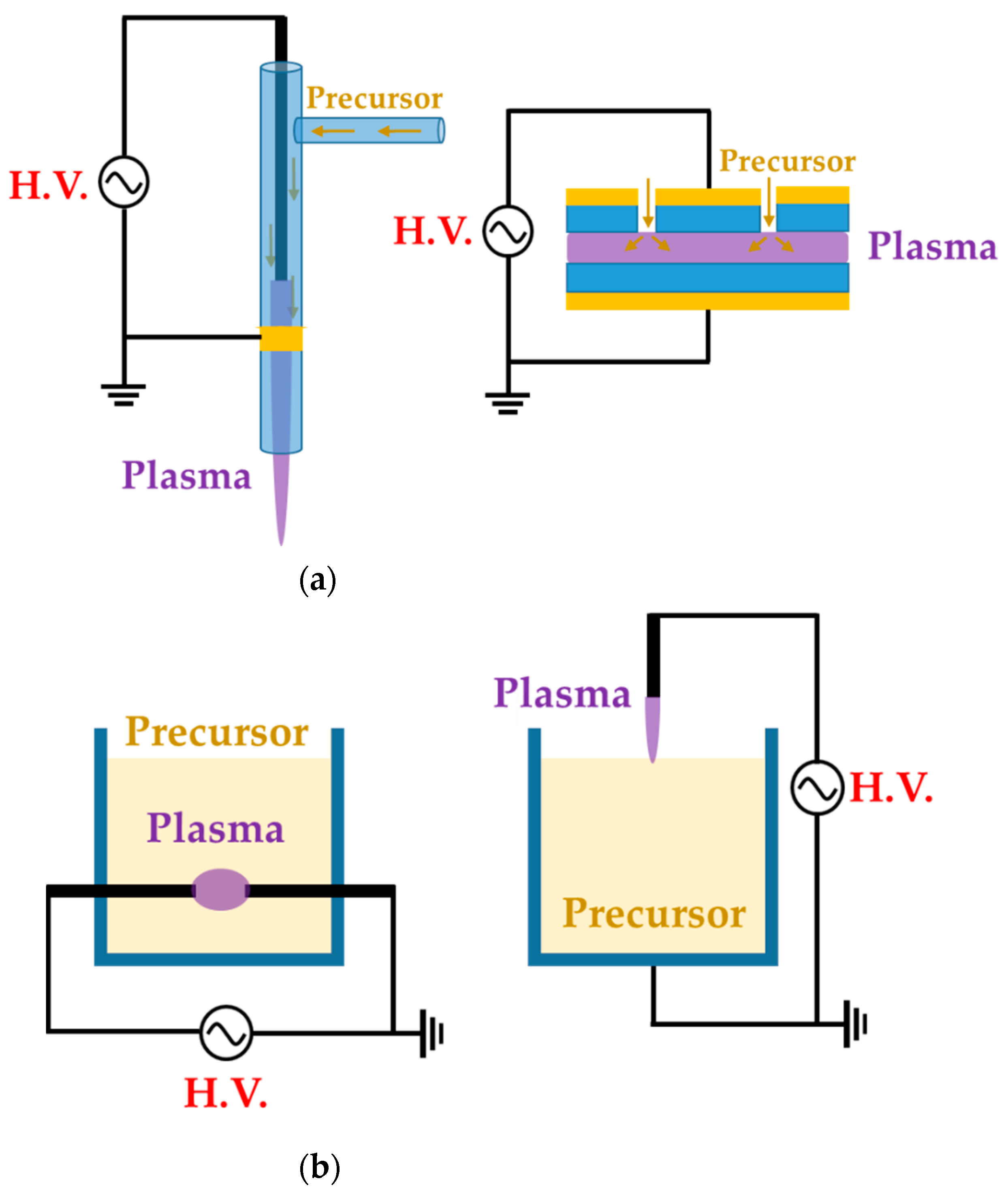
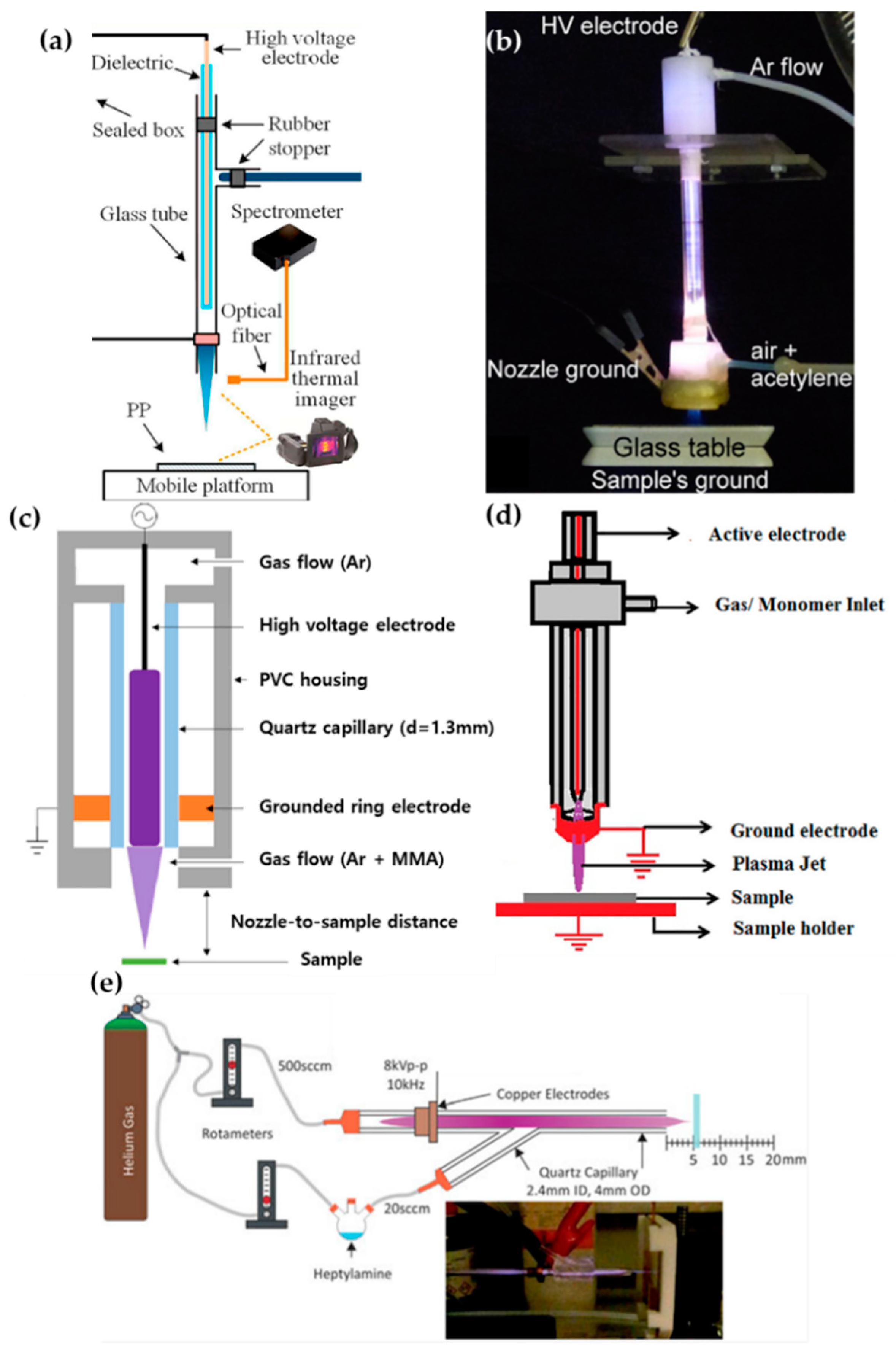


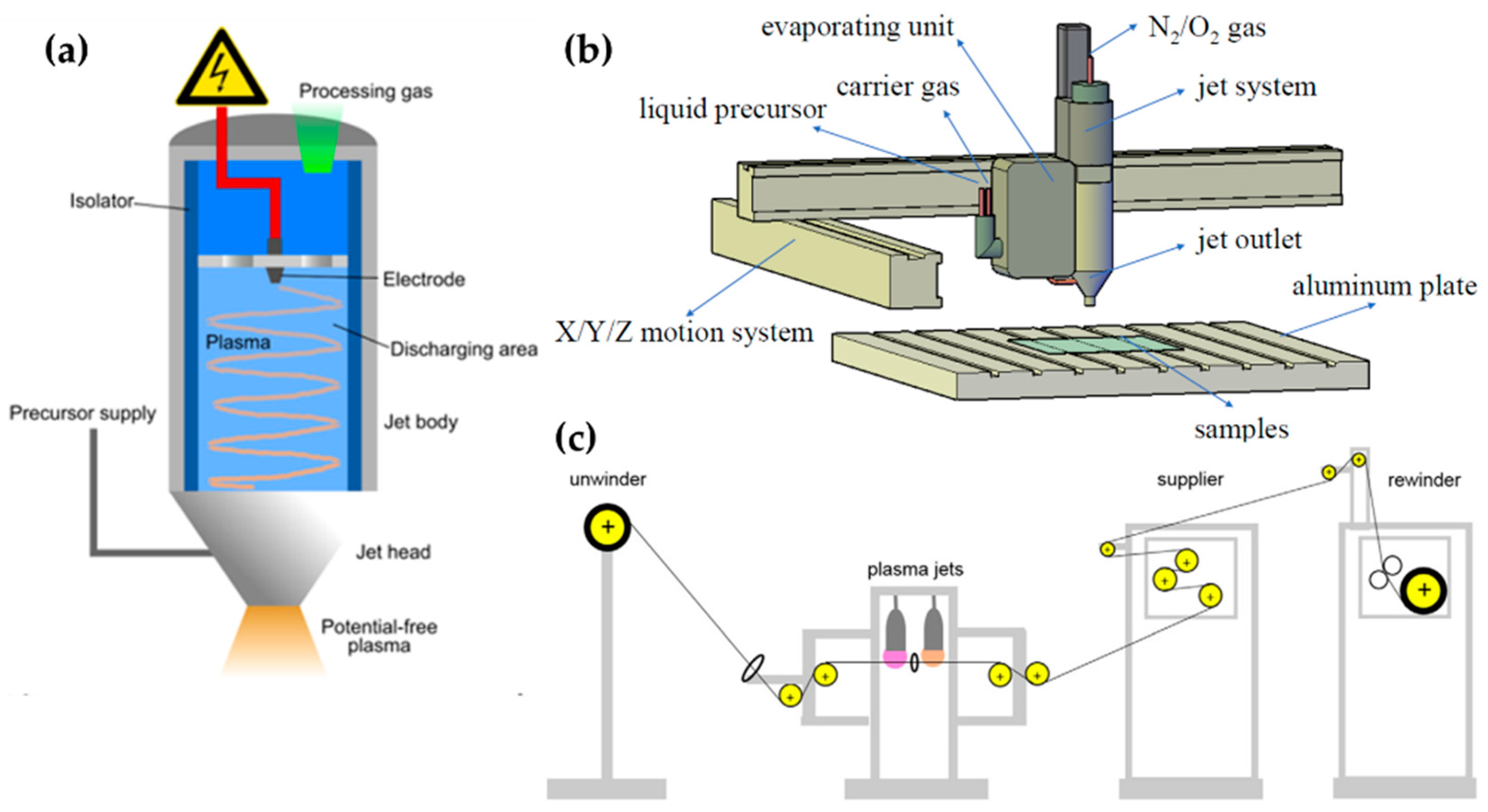
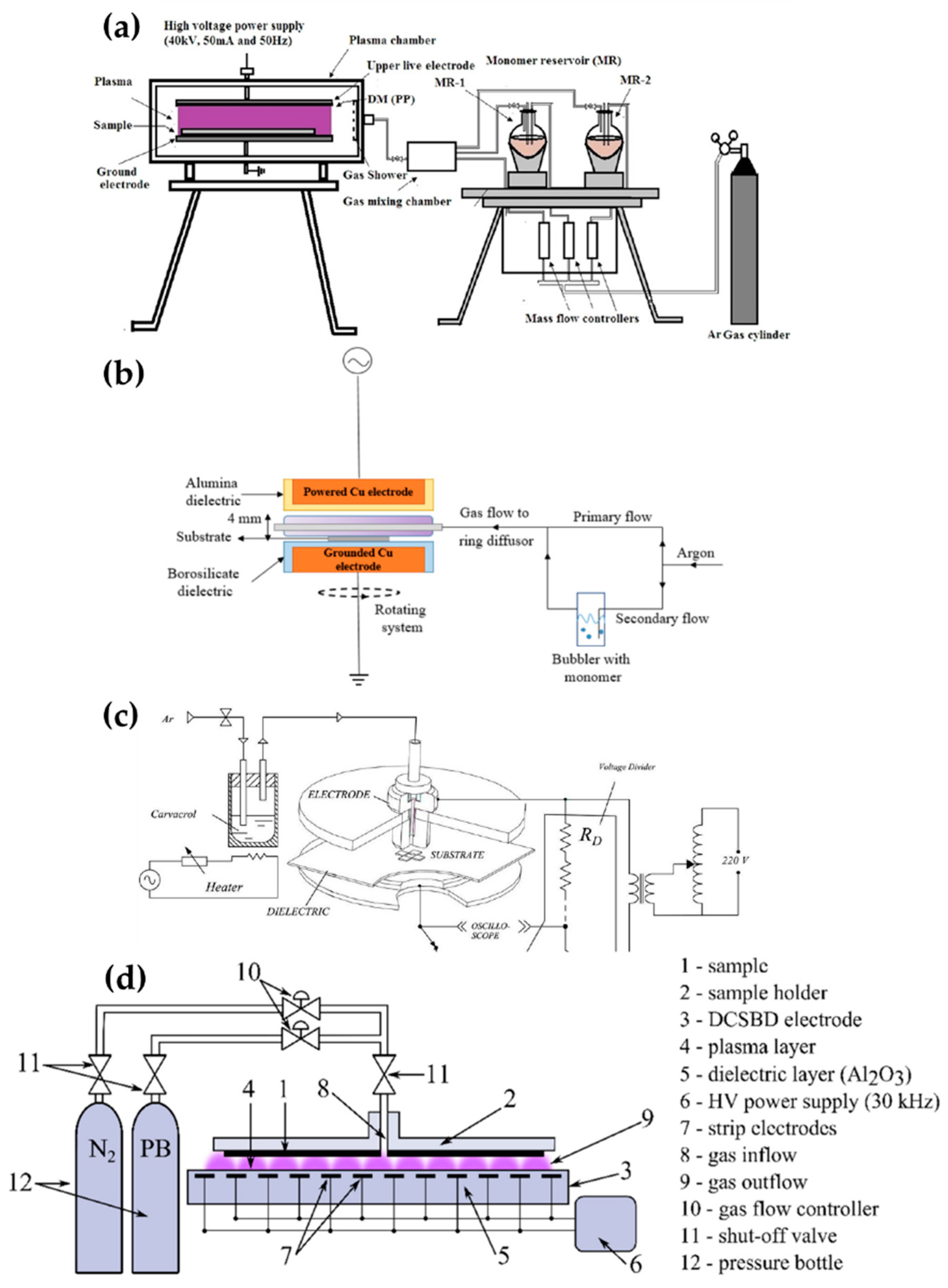



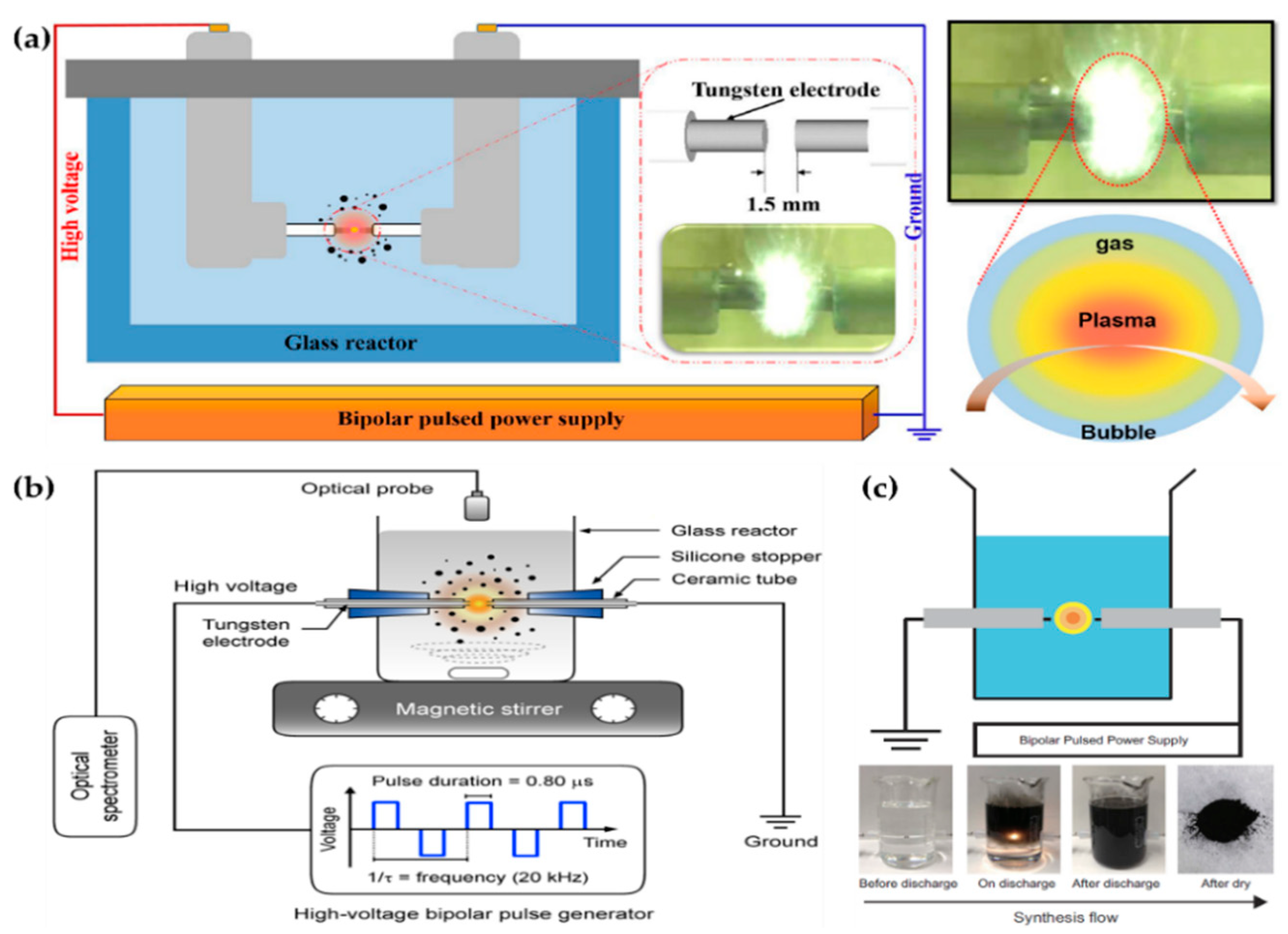

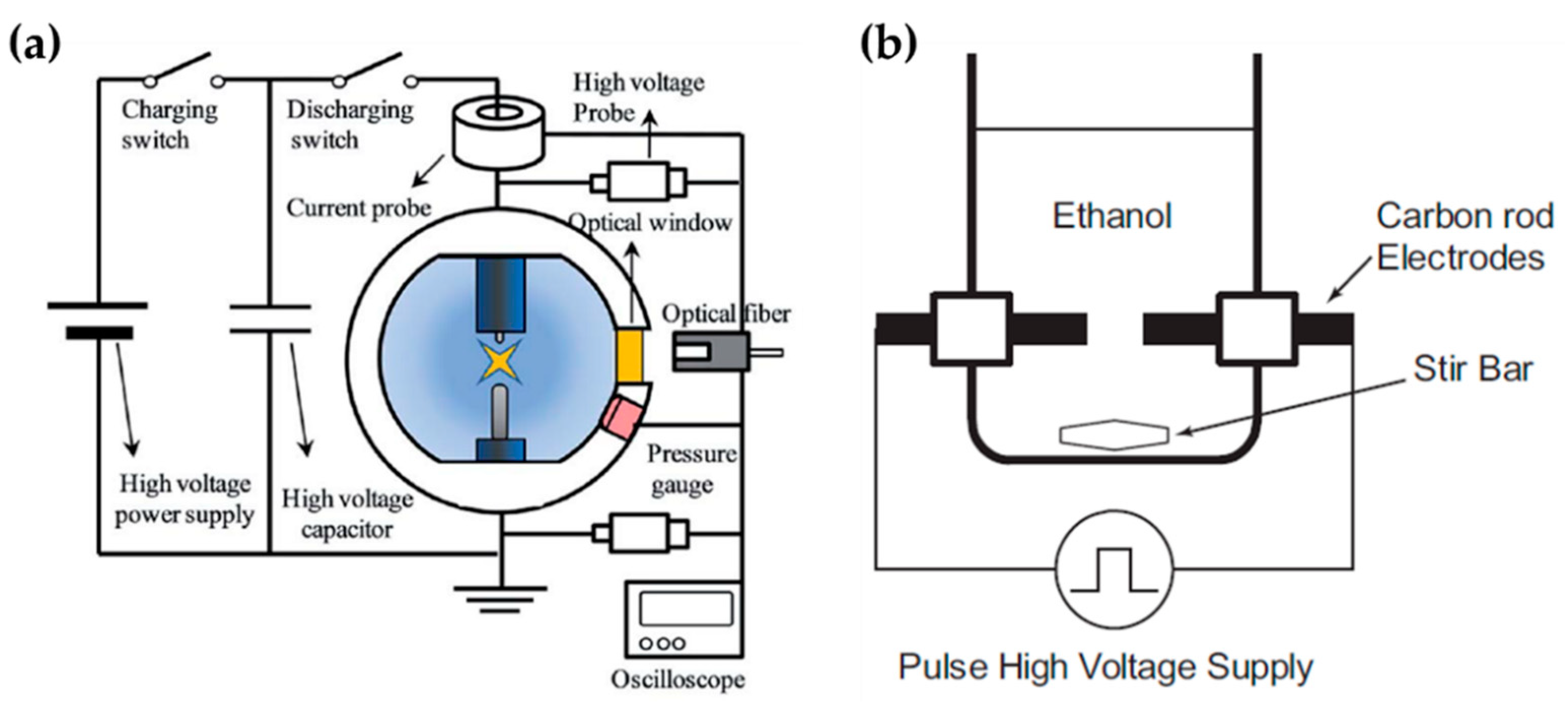

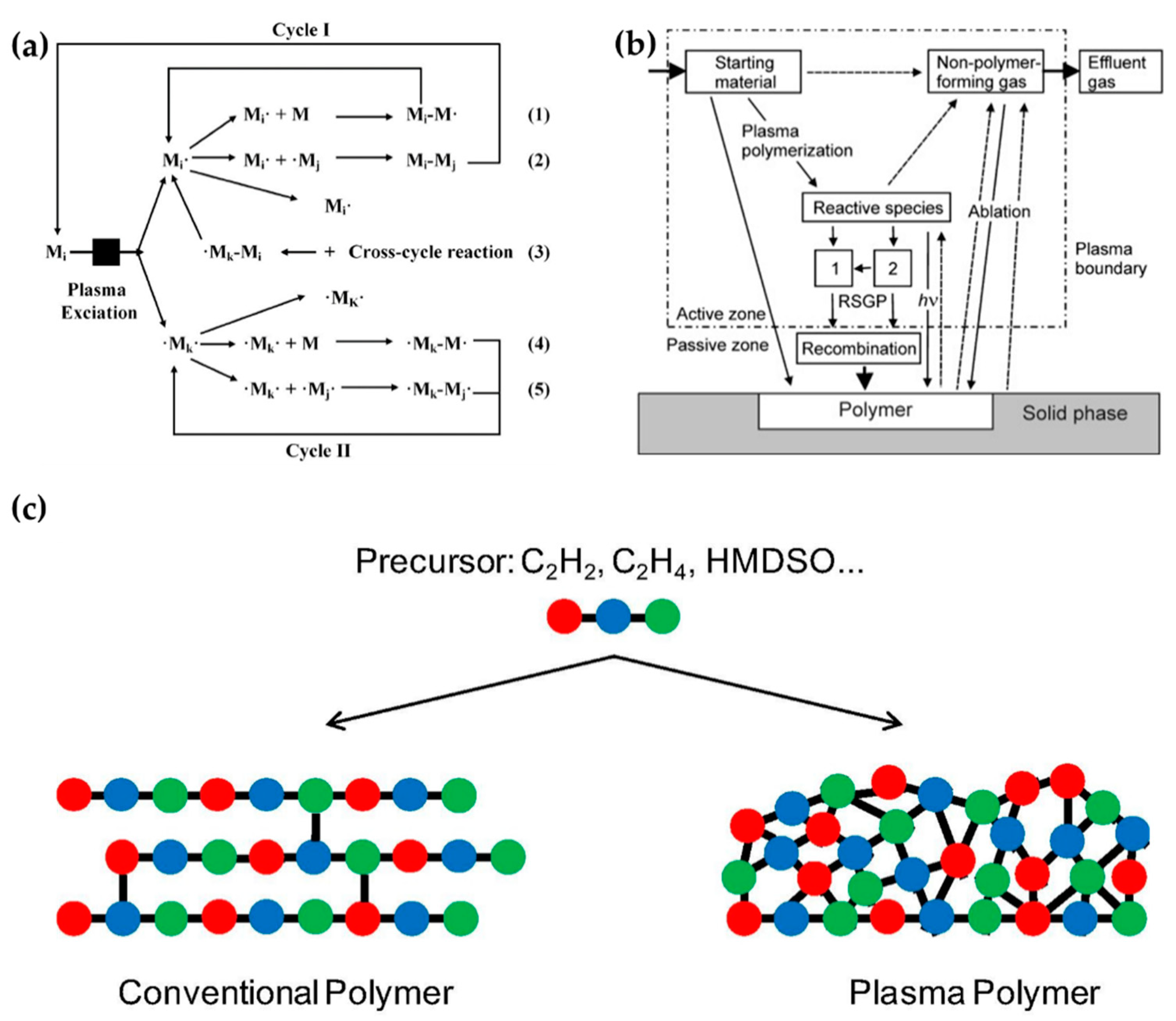

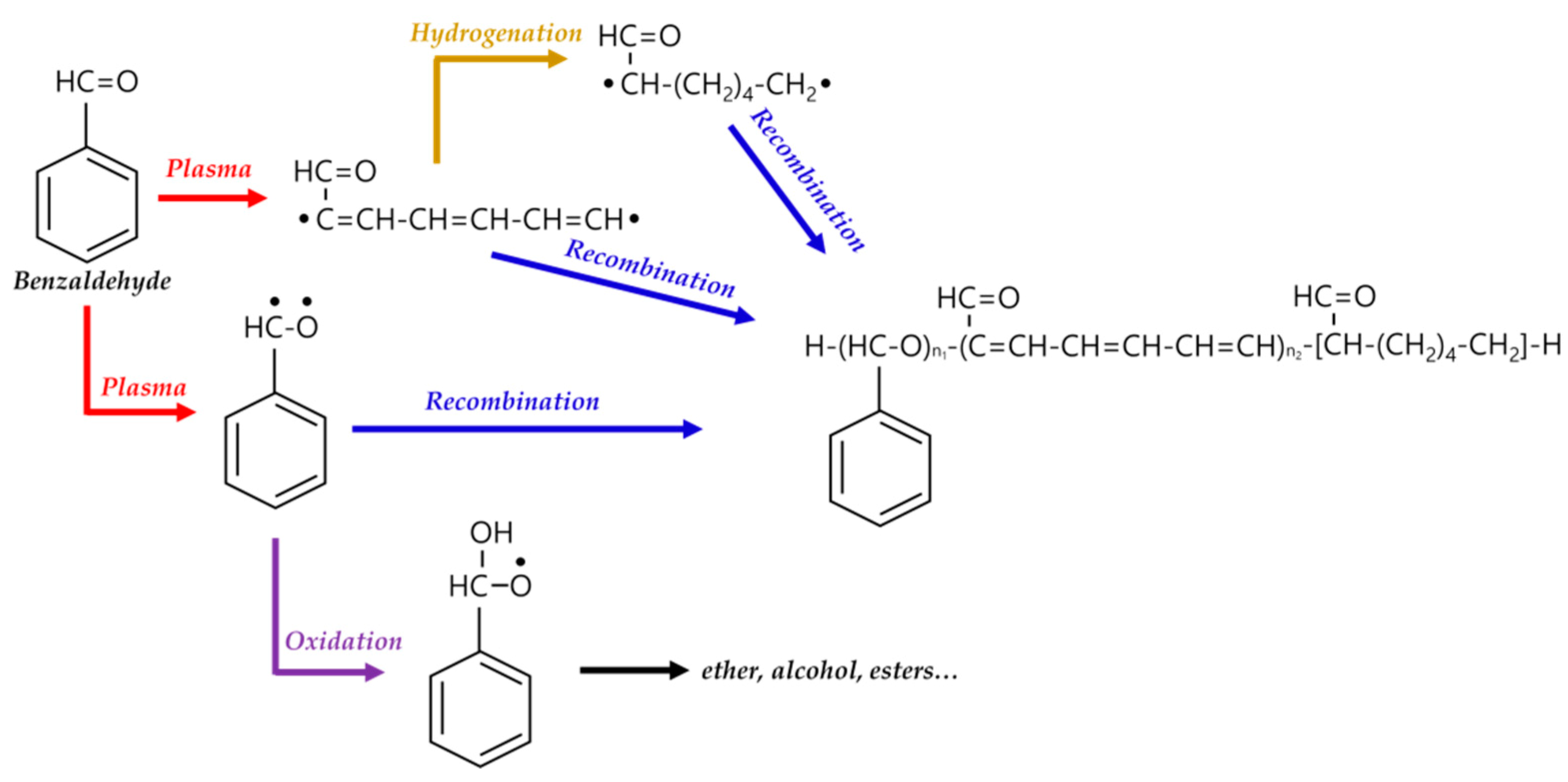
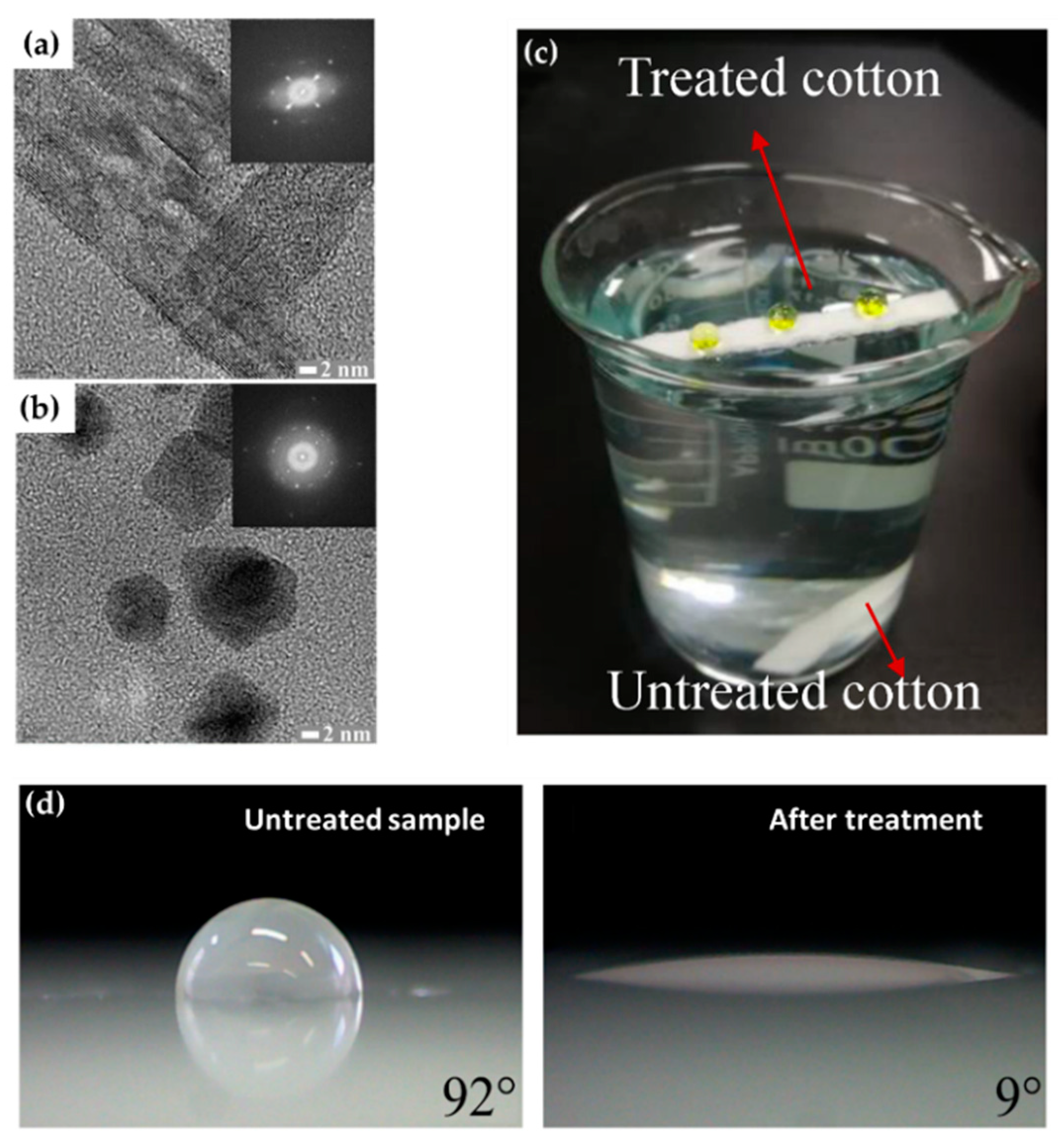
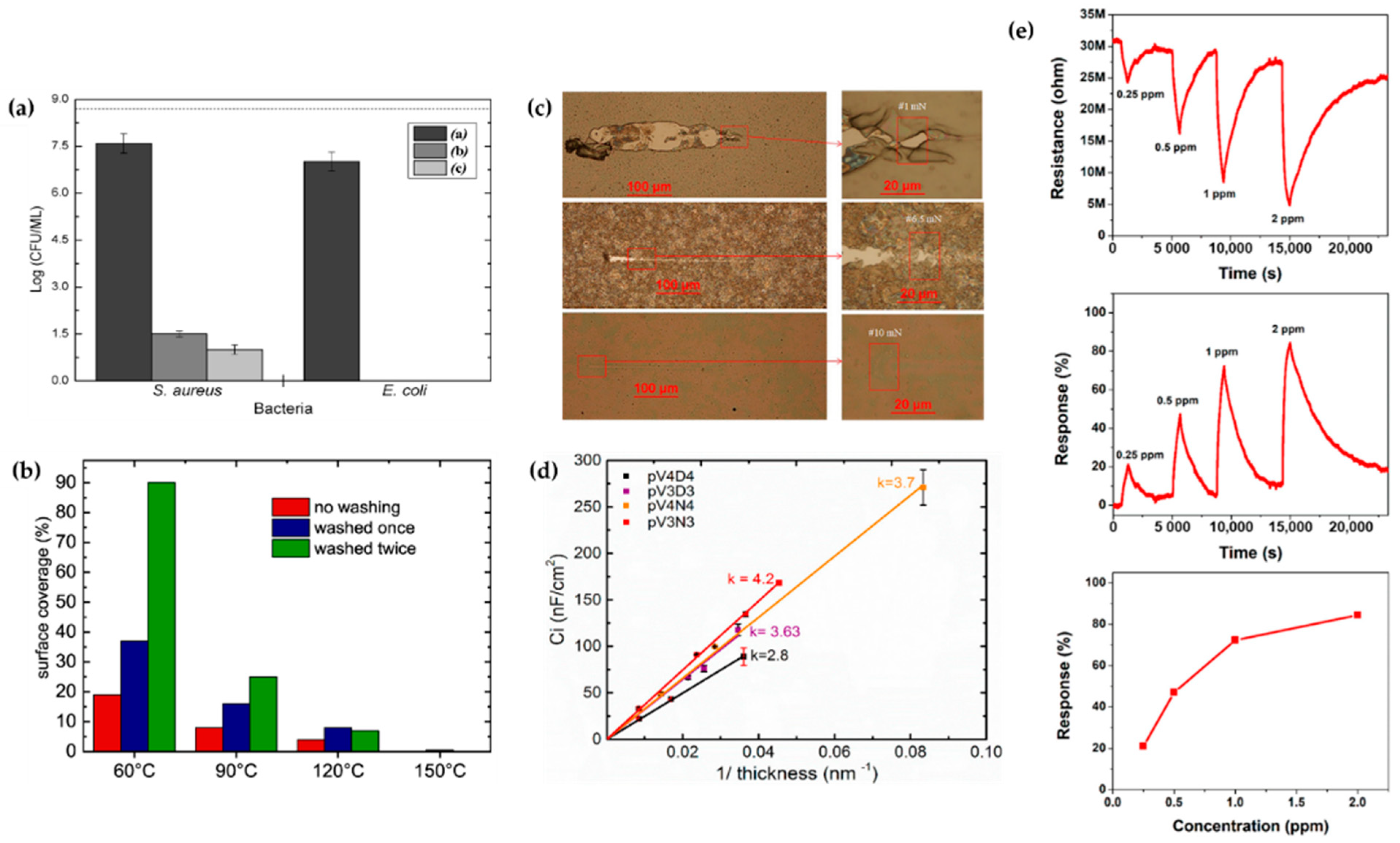
| No | Object | Precursor | Power | Year | Author Reference |
|---|---|---|---|---|---|
| 1 | Improvement of flashover performance of polypropylene surface | methyl-methacrylate (MMA) | Ar gas RF power (17 kV, 10~60 kHz) | 2020 | Zhang et al. [51] |
| 2 | Deposition of polymer film from Ar/air/acetylene | Acetylene | Air, Ar gas AC Pulse (Sine) (12 kV, 19 kHz, 2.8 W) | 2017 | Ricci Castro et al. [52] |
| 3 | Deposition of PMMA film | MMA | Ar gas AC Pulse power (23 kHz, 2 W) | 2018 | Vrekhem et al. [53] |
| 4 | Deposition of phosphorous containing functional coatings | Triisopropyl phosphate (TIP) | Ar gas (1 kPa) AC Pulse power (40 kV, 50 kHz) | 2019 | Pandiyaraj et al. [54] |
| 5 | Polymerization of heptylamine | Heptylamine | He gas AC Pulse (Sine) (8 kV, 10 kHz) | 2019 | Doherty et al. [55] |
| 6 | Polymerization of HMDSN | Hexamethyldisilazane (HMDSN) | Air, Ar gas AC Pulse (Sine) (12 kV, 19 kHz, 2.8 W) | 2017 | Kodaira et al. [56] |
| 7 | Superhydrophobic coating | Tetramethylsilane (TMS), 3-aminopropyl(diethoxy)methylsilane (APDMES) | Ar gas RF power (7.5 kV, 11.5 kHz) | 2019 | Hossain et al. [57] |
| 8 | Durable bioactive coating | Laccase | He gas AC Pulse (2∼6 kV, 20 kHz) | 2018 | Malinowski et al. [58] |
| 9 | Copolymerization | Mixture of thiophene and Aniline | Ar gas AC Pulse (Sine) (23 kV, 26 kHz) | 2020 | Jang et al. [59] |
| 10 | Polymerization of PMMA | MMA | Ar gas AC Pulse (Sine) (12 kV, 30 kHz) | 2019 | Park et al. [60] |
| 11 | Humidity-independent conducting polymer | aniline | Ar gas AC Pulse (Sine) (8 kV, 26 kHz) | 2017 | Park et al. [61] |
| 12 | Single-crystalline polymer film | Pyrrole | Ar gas AC Pulse (Sine)(12 kV, 30 kHz) | 2017 | Kim et al. [62] |
| 13 | Conducting polymer film | aniline | Ar gas AC Pulse (Sine) (5 kV, 30 kHz) | 2021 | Kim et al. [63] |
| 14 | Transparent thin film | aniline | Ar gas AC Pulse (Sine) (4 kV, 30 kHz) | 2021 | Kim et al. [64] |
| 15 | Deposition from organosilicon | HMDSO, Tetraethyl orthosilicate (TEOS) | Air, N2 gas Pulse power (19 kHz, 1 kW) | 2020 | Karl et al. [65] |
| 16 | Preservation of paper-based relics | HMDSO | Air, Ar gas Pulse power | 2019 | Yan et al. [66] |
| 17 | Superhydrophobic cotton fabrics | HMDSO | O2, N2 gas RF power (19 kHz) | 2018 | Yang et al. [67] |
| 18 | Reinforcement of carbon fiber | Methyltrimethoxysilane (MTMS) | Ar gas AC Pulse (252 V, 21 kHz, 600 W) | 2017 | Moosburger-Will et al. [68] |
| No | Object | Precursor | Plasma Source | Year | Author Reference |
|---|---|---|---|---|---|
| 1 | Improvement of antifouling properties | mixture of acrylic acid (AAC) and poly (ethylene glycol) (PEG) | Ar gas AC Pulse (14 kV, 44 kHz) | 2019 | Pandiyaraj et al. [69] |
| 2 | Enhancement of biocompatibility | poly (ethylene glycol) methylether methacrylate (PEGMA) | Ar gas AC Pulse (14 kV, 44 kHz) | 2017 | Ramkumar et al. [70] |
| 3 | Hydrophilic and hydrophobic coatings | 11 precursors for hydrophilic and hydrophobic coatings | Ar gas AC Pulse (17.1 kHz) | 2020 | Mertens et al. [71] |
| 4 | Inhibition of bacteria adhesion and proliferation | Carvacrol (5-Isopropyl-2-methylphenol, (CH3)2CHC6H3(CH3)OH) | Ar gas AC Pulse (15 kV, 60 Hz) | 2020 | Getnet et al. [72] |
| 5 | Surface hydrophilization | propane-butane (PB) gas | N2 gas AC Pulse (30 kHz) | 2019 | Dvorˇáková et al. [73] |
| 6 | Reinforcement of mechanical properties of DOCA film | Dodecyl acrylate (DOCA), 1,6-hexanediol diacrylate (HdiA), 1,6-hexanediol dimethacrylate (HdiMA) | He gas AC Pulse (11 kV, 10 kHz, 110 W) | 2018 | Bardon et al. [74] |
| 7 | Carboxyl-rich coatings | maleic anhydride (MA), acetylene | Ar gas AC Pulse (Sine) (4 kV, 5∼6.6 kHz, 8 W) | 2016 | Manakhov et al. [75] |
| 8 | Copolymerization | MA, acetylene | Ar gas AC Pulse (4 kV, 4 kHz, 3.3 W) | 2017 | Obrusník et al. [76] |
| 9 | Antibacterial properties and cytocompatibility performance | 2-methyl-2-oxzoline, polyoxazoline (POx) | Ar gas AC Pulse (6 kHz, 55 W) | 2019 | St’ahel et al. [77] |
| 10 | Hydrophilic/phobic patterns | acrylic acid (AA) propargyl methacrylate (PMA) | Ar, O2 gas AC Pulse (Sine) (16.2 kHz, 90 W) | 2019 | Demaude et al. [78] |
| 11 | Age-resistant coatings with tunable wettability | AA, PMA | Ar gas AC Pulse (Sine) (15.64 kHz, 30 to 90 W) | 2016 | Nisol et al. [79] |
| 12 | Preparation of tunable catechol-bearing thin films | dopamine acrylamide (DOA) 2-hydroxyethyl methacrylate monomer (HEMA) | Ar, O2 gas AC Pulse (Sine) (10 kHz) | 2019 | Jalaber et al. [80] |
| 13 | Hydrophilicity | HMDSO | Ar gas 13.56 MHz RF (30 W) | 2020 | Ma et al. [81] |
| 14 | Low-k Polymer Insulating Layers | 4 cyclic organosilicon monomers | N2 gas AC square Pulse (6 kV, 100 Hz) | 2019 | Ondo et al. [82] |
| 15 | Comparison of polymer properties according to applied duty cycle | 3 methacrylate monomers (MMA, BMA, GMA) | Ar gasAC square Pulse (6.5 kV, 10 kHz) | 2017 | Loyer et al. [83] |
| 16 | Comparison of polymer properties according to applied duty cycle | 2 methacrylate monomers (MMA, GMA) | Ar gas AC square Pulse (6.5 kV, 10 kHz) | 2018 | Loyer et al. [84] |
| 17 | Deposition of NVCL with water-stable and thermo-responsive properties | N-vinyl caprolactam (NVCL) ethylene glycol dimethacrylate (EGDMA) | Ar gas AC square Pulse (6.5 kV, 10 kHz) | 2019 | Loyer et al. [85] |
| No | Object | Precursor | Plasma Source | Year | Author Reference |
|---|---|---|---|---|---|
| 1 | Plasma-treated styrene | Styrene | Ar gas AC Pulse (15 kV, 60 Hz, 450 W) | 2018 | Tan et al. [93] |
| 2 | Plasma-treated MMA | MMA | Ar gas AC Pulse (15 kV, 60 Hz, 450 W) | 2020 | Tan et al. [94] |
| 3 | Thin, solid SiOx film | HMDSO, octamethyltetrasiloxane (OMCTS), tetrakis(trimethylsilyloxy)silane (TTMS) | Ar gas AC Pulse (1.1 MHz, 5 W) | 2017 | Schäfer et al. [95] |
| 4 | Metallic NPs embedded in a conducting polymer | HAuCl4 aqueous solution, poly(3,4-ethylenedioxy thiophene) polystyrene sulfonate (PEDOT:PSS) | He gas DC Pulse (ignition 2 kV, maintain 0.8 kV) | 2017 | Zhang et al. [96] |
| 5 | Nanographene | Ethanol | AC high voltage | 2018 | Gamaleev et al. [97] |
| No | NPs | Electrode (Gap) | Precursor | Plasma Source | Year | Author Reference |
|---|---|---|---|---|---|---|
| 1 | Nitrogen–carbon nanosheets (NCNS) | Tungsten (1 mm) | N-methyl-2-pyrrolidone | Bipolar Pulse (2 kV, 25–200 kHz, 1 μs) | 2016 | Hyun et al. [103] |
| 2 | NCNS | Tungsten (1 mm) | 2-Pyrrolidone, 1-methylpyrrolidine, pyrrolidine, pyrrole, cyclopentanone, and cyclohexanone | Bipolar Pulse (2 kV, 200 kHz, 1 μs) | 2017 | Hyun et al. [104] |
| 3 | Nitrogen-doped carbon nanoparticles (NCNPs) | Tungsten (1 mm) | Cyanopyridine, cyanopyrazine | Bipolar Pulse (20 kHz, 0.8 μs) | 2016 | Panomsuwan et al. [105] |
| 4 | Nanocarbons | Tungsten (0.5 mm) | Hexane, hexadecane, cyclohexane, benzene | Bipolar Pulse (1.7 kV, 15 kHz, 1 μs) | 2016 | Morishita et al. [106] |
| 5 | Boron–carbon–nitrogen nanocarbons | Tungsten (1 mm) | Pyridine, B-tribromoborazine, boric acid | Bipolar Pulse (2 kV, 100 kHz, 0.5 μs) | 2017 | Lee et al. [107] |
| 6 | Carbon | Tungsten (0.5 mm) | Pyrazine, acrylonitrile | Bipolar Pulse (2 kV, 20 kHz, 1 μs) | 2016 | Li et al. [108] |
| 7 | Amino-modified nanocarbon | Tungsten (1 mm) | Phenol (3-aminopropyl)triethoxysilane (APTES) | Bipolar Pulse (4 kV, 15 kHz, 1 μs) | 2020 | Tipplook et al. [109] |
| 8 | Carbon TiOX/carbon composite nanosheets | Tungsten (5 mm) | Ti-contained solution | DC (19 kV) | 2015 | Lee et al. [91] |
| 9 | Carbon, Pt–carbon | Carbon (1 mm) | Ethanol | Pulse (4 kV, 30 kHz, 4 μs) | 2019 | Alsaeedi et al. [110] |
| 10 | Polyaniline | Tungsten (1 mm) | Aniline | Bipolar Pulse (16.4 kV, 5 kHz, 60 μs) | Shin et al. [111] | |
| 11 | Polyaniline | Tungsten–copper (4 mm) | Aniline | Bipolar Pulse (16 kV, 5 kHz, 100 μs) | Shin et al. [112] |
Publisher’s Note: MDPI stays neutral with regard to jurisdictional claims in published maps and institutional affiliations. |
© 2021 by the authors. Licensee MDPI, Basel, Switzerland. This article is an open access article distributed under the terms and conditions of the Creative Commons Attribution (CC BY) license (https://creativecommons.org/licenses/by/4.0/).
Share and Cite
Jang, H.J.; Jung, E.Y.; Parsons, T.; Tae, H.-S.; Park, C.-S. A Review of Plasma Synthesis Methods for Polymer Films and Nanoparticles under Atmospheric Pressure Conditions. Polymers 2021, 13, 2267. https://doi.org/10.3390/polym13142267
Jang HJ, Jung EY, Parsons T, Tae H-S, Park C-S. A Review of Plasma Synthesis Methods for Polymer Films and Nanoparticles under Atmospheric Pressure Conditions. Polymers. 2021; 13(14):2267. https://doi.org/10.3390/polym13142267
Chicago/Turabian StyleJang, Hyo Jun, Eun Young Jung, Travis Parsons, Heung-Sik Tae, and Choon-Sang Park. 2021. "A Review of Plasma Synthesis Methods for Polymer Films and Nanoparticles under Atmospheric Pressure Conditions" Polymers 13, no. 14: 2267. https://doi.org/10.3390/polym13142267
APA StyleJang, H. J., Jung, E. Y., Parsons, T., Tae, H.-S., & Park, C.-S. (2021). A Review of Plasma Synthesis Methods for Polymer Films and Nanoparticles under Atmospheric Pressure Conditions. Polymers, 13(14), 2267. https://doi.org/10.3390/polym13142267






